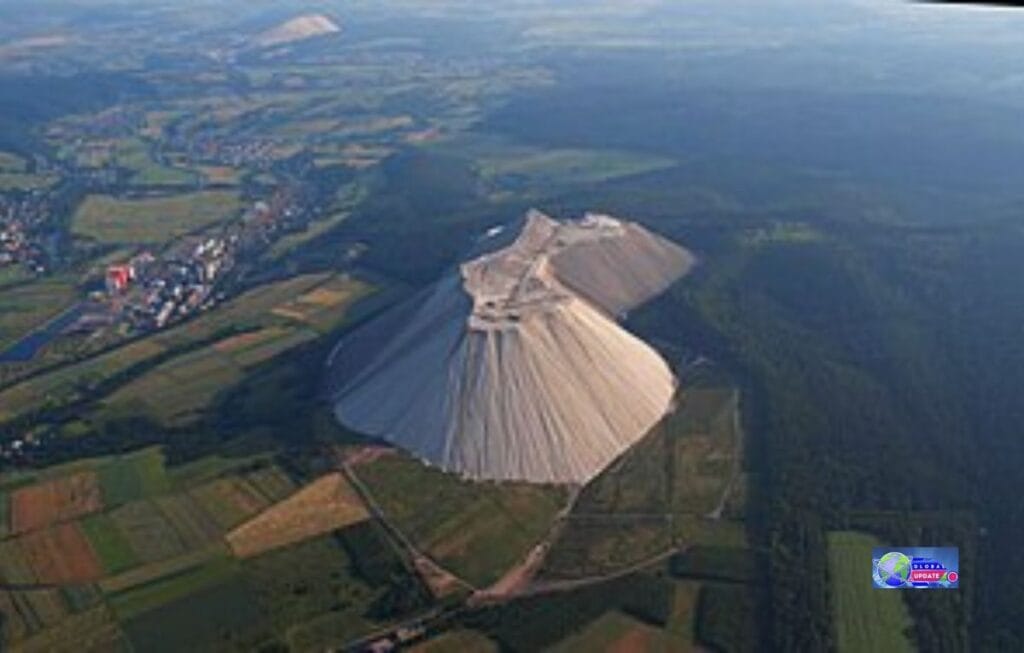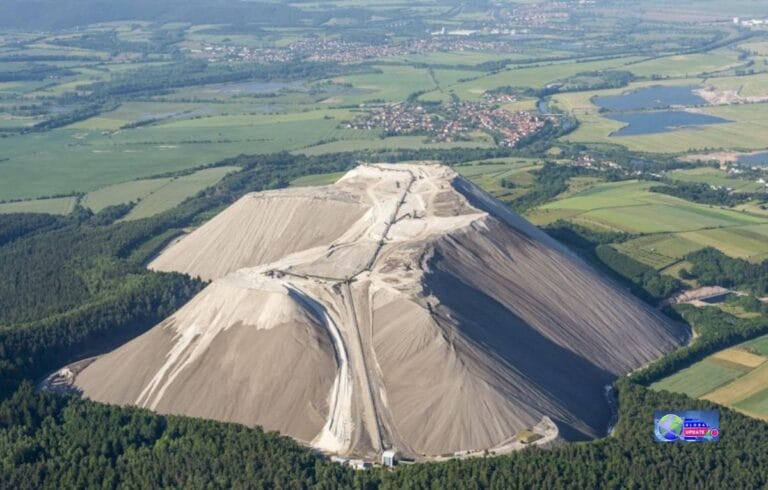Potash salt began to be extracted from mines near the town of Hessen in 1976. It is where Monte Kali got its start.
There is a fantastic mountain in the quiet German town of Heringen, which is in the state of Hesse. It is entirely white, continues to grow, and is composed of salt.
It’s called Monte Kali, and it’s a stunning example of industrial ambition, human effect, and natural beauty.
But this isn’t your normal tourist mountain. It’s a salt mountain, the world’s biggest artificial one, and its story is just as interesting as its snow-covered slopes
Who is Monte Kali?
Mountain Monte Kali, which locals sometimes refer to as “Kilimanjaro” in jest, is a massive pile of sodium chloride (NaCl), commonly known as table salt.
It is more than 100 hectares in size and over 250 meters tall, and it continues to grow larger every year.
Monte Kali started to rise in 1976, but most mountains take millions of years to form.
It was made entirely from the waste from potash mining.

Potash mining in Germany is where it all began.
Potash is a naturally occurring mineral high in potassium, used in various industrial products, fertilisers, and detergents. Some of the largest potash deposits in Europe are located in Germany, particularly in the states of Hesse and Thuringia.
Potash ore is taken out of the ground at the K+S Group mining site in Heringen. During this process, only a small amount of the chemical is potassium that can be used.
Up to 94% of what’s left is sodium chloride. This used salt is piling up because it has nowhere else to go. This is how Monte Kali came to be.
A mountain that keeps getting bigger.
About 9000 tons of salt are added to Monte Kali every day. Every day, that’s about 70 blue whales’ worth of weight!
As a result? A bright white peak that keeps growing and can be seen from miles away. It stands out against the green hills and slopes around it in a big way.
Monte Kali has more than 230 million tons of salt, and this number is likely to continue increasing. They believe it could double in size within decades if no action is taken.
Concerns about the environment.
It’s unclear why Monte Kali exists, regardless of how amazing it is. Concerns about damage to the environment are growing because salt is being dumped all the time:
Adding salt to bodies of water: The groundwater and rivers in the area are becoming increasingly salty, which is detrimental to marine life and the water quality.
Effects on the soil: Salt can harm farming by altering the soil’s composition and damaging crops.
Animals and plants: Excessive salt levels upset the environment, putting native animals and plants at risk.
Environmentalists have long advocated for alternative methods to manage waste, such as recycling salt or adopting more environmentally friendly mining practices. Some progress has been made, but problems still need to be solved.
Going to Monte Kali.
Although Monte Kali was once an industrial area, it has evolved into an unusual vacation destination.
What Are You Able To Do?
Guided tours: On select days, individuals can ascend Salt Mountain with the assistance of local guides who provide insights into the mountain’s history, science, and environmental impact.
Views of the entire area, including the Werra Valley, Heringen town, and parts of Thuringia, will be breathtaking from the top.
As an educational bonus, tours often include stops at nearby museums and historic sites, such as potash mines.
Please note that you will need to wear sunglasses. The white salt is very reflective and shines clearly in the sun. For the hike, wear sturdy shoes.
A sign of business and influence.
It’s not just a weird place to visit Monte Kali. It illustrates the complex relationship between business and the environment. It’s a quiet, sparkling reminder of both progress and consequence—a physical record of decades of mining work.
Know what?
The word “Kali” comes from the German word for potash, “Kalisalz.”
Because Monte Kali is so big, its reflected heat has slightly changed the weather in the area.
Some environmentalists refer to Monte Kali as “Germany’s white scar” because it illustrates what can happen when waste isn’t adequately controlled.
Last Thoughts
Even though Monte Kali isn’t a natural wonder, it is a modern marvel. It’s a mountain that was built by people, not by tectonic changes.
Scientists, tourists, environmentalists, and individuals seeking something interesting are all drawn to it.
Monte Kali is a unique place that you should add to your travel list, whether you view it as an example of environmental protection or as a distinctive industrial landmark.
So, if you’re ever in the middle of Germany, take a side trip to see this massive salt tower, which is an unexpected mix of business and nature.
Keep on Reading:
- Chagos Islands: A Disputed Paradise in the Indian Ocean
- Pakistani Cricketers Join Big Bash League 2025: Check Complete List



